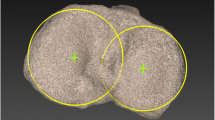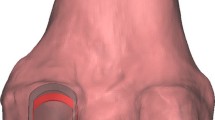Abstract
Background
It is difficult to implant components in the correct rotational position in the narrow operating field in a unicompartmental knee arthroplasty. Although no rotational reference has been confirmed for unicompartmental knee arthroplasty, the AP axis of the tibia may serve as a reference for unicompartmental knee arthroplasty and TKA. However, it is difficult to identify the AP axis during unicompartmental knee arthroplasty, especially with the tibia first-cut technique.
Questions/purposes
We explored whether the medial wall of the intercondylar notch could be useful for the tibial rotational reference as an alternative to the AP axis in unicompartmental knee arthroplasty.
Methods
We scanned the knees of 24 healthy Asian patients (45 knees) at a flexion angle of 90º using open MRI, then measured the angle between the AP axis and the medial wall of the notch. We determined whether the origins of the ACL and PCL were located lateral to the line on the medial wall of the notch and whether the mediolateral dimension of the bone cut surface of the medial tibial plateau was wide enough relative to the AP dimension to use the commercially available unicompartmental knee arthroplasty tibial components when the tibia was cut parallel to the medial wall of the notch.
Results
At 90º flexion the medial wall of the notch was externally rotated 0.1º ± 4.4º relative to the AP axis. In all knees, the ACL and PCL were located lateral to the line on the medial wall of the notch. The mediolateral dimension of the bone cut surface was wide enough to use the commercially available tibial components.
Conclusions
At 90º flexion the medial wall of the intercondylar notch is almost parallel to the AP axis of the tibia at and we believe a reasonable candidate for a rotational reference of tibial placement in unicompartmental knee arthroplasty. This landmark would need to be confirmed in other populations and in patients with osteoarthritis.






Similar content being viewed by others
References
Akagi M, Oh M, Nonaka T, Tsujimoto H, Asano T, Hamanishi C. An anteroposterior axis of the tibia for total knee arthroplasty. Clin Orthop Relat Res. 2004;420:213–219.
Akizuki S, Mueller JK, Horiuchi H, Matsunaga D, Shibakawa A, Komistek RD. In vivo determination of kinematics for subjects having a Zimmer Unicompartmental High Flex Knee System. J Arthroplasty. 2009;24:963–971.
Berger RA, Crossett LS, Jacobs JJ, Rubash HE. Malrotation causing patellofemoral complications after total knee arthroplasty. Clin Orthop Relat Res. 1998;356:144–153.
Berger RA, Meneghini RM, Jacobs JJ, Sheinkop MB, Della Valle CJ, Rosenberg AG, Galante JO. Results of unicompartmental knee arthroplasty at a minimum of ten years of follow-up. J Bone Joint Surg Am. 2005;87:999–1006.
Berger RA, Rubash HE, Seel MJ, Thompson WH, Crossett LS. Determining the rotational alignment of the femoral component in total knee arthroplasty using the epicondylar axis. Clin Orthop Relat Res. 1993;286:40–47.
Carr A, Keyes G, Miller R, O’Connor J, Goodfellow J. Medial unicompartmental arthroplasty: a survival study of the Oxford meniscal knee. Clin Orthop Relat Res. 1993;295:205–213.
Cartier P, Sanouiller JL, Grelsamer RP. Unicompartmental knee arthroplasty surgery: 10-year minimum follow-up period. J Arthroplasty. 1996;11:782–788.
Churchill DL, Incavo SJ, Johnson CC, Beynnon BD. The transepicondylar axis approximates the optimal flexion axis of the knee. Clin Orthop Relat Res. 1998;356:111–118.
Colle F, Bignozzi S, Lopomo N, Zaffagnini S, Sun L, Marcacci M. Knee functional flexion axis in osteoarthritic patients: comparison in vivo with transepicondylar axis using a navigation system. Knee Surg Sports Traumatol Arthrosc. 2011 Jul 14. [Epub ahead of print].
Engh GA, Ammeen D. Is an intact anterior cruciate ligament needed in order to have a well-functioning unicondylar knee replacement? Clin Orthop Relat Res. 2004;428:170–173.
Goodfellow JW, O’Connor JJ. Oxford Meniscal Knee: Phase II: Unicompartmental Replacement Principles and Techniques. Biomet UK Ltd, Bridgend, South Wales; 1999.
Hernigou P, Deschamps G. Alignment influences wear in the knee after medial unicompartmental arthroplasty. Clin Orthop Relat Res. 2004;423:161–165.
Hitt K, Shurman JR 2nd, Greene K, McCarthy J, Moskal J, Hoeman T, Mont MA. Anthropometric measurements of the human knee: correlation to the sizing of current knee arthroplasty systems. J Bone Joint Surg Am. 2003;85:115–122.
Hollister AM, Jatana S, Singh AK, Sullivan WW, Lupichuk AG. The axes of rotation of the knee. Clin Orthop Relat Res. 1993;290:259–268.
Hovinga KR, Lerner AL. Anatomic variations between Japanese and Caucasian populations in the healthy young adult knee joint. J Orthop Res. 2009;27:1191–1196.
Insall JN, Easley ME. Surgical techniques and instrumentation in total knee arthroplasty. In: Insall JN, Scott WN, eds. Surgery of the Knee. Ed 3. New York, NY: Churchill Livingstone; 2001:1553–1620.
Kennedy WR, White RP. Unicompartmental arthroplasty of the knee: postoperative alignment and its influence on overall results. Clin Orthop Relat Res. 1987;221:278–285.
Kozinn SC, Scott R. Unicondylar knee arthroplasty. J Bone Joint Surg Am. 1989;71:145–150.
Laskin RS. Unicompartmental knee replacement: some unanswered questions. Clin Orthop Relat Res. 2001;392:267–271.
Mizu-uchi H, Matsuda S, Miura H, Higaki H, Okazaki K, Iwamoto Y. Three-dimensional analysis of computed tomography-based navigation system for total knee arthroplasty: the accuracy of computed tomography-based navigation system. J Arthroplasty. 2009;24:1103–1110.
Moreland JR, Bassett LW, Hanker GJ. Radiographic analysis of the axial alignment of the lower extremity. J Bone Joint Surg Am. 1987;69:745–749.
Müller PE, Pellengahr C, Witt M, Kircher J, Refior HJ, Jansson V. Influence of minimally invasive surgery on implant positioning and the functional outcome for medial unicompartmental knee arthroplasty. J Arthroplasty. 2004;19:296–301.
Murray DW, Goodfellow JW, O’Connor JJ. The Oxford medial unicompartmental arthroplasty: a ten-year survival study. J Bone Joint Surg Br. 1998;80:983–989.
Ridgeway SR, McAuley JP, Ammeen DJ, Engh GA. The effect of alignment of the knee on the outcome of unicompartmental knee replacement. J Bone Joint Surg Br. 2002;84:351–355.
Scott RD. Unicompartmental total knee arthroplasty. In: Insall JN, Scott WN, eds. Surgery of the Knee. Ed 3. New York, NY: Churchill Livingstone; 2001:1621–1628.
Servien E, Saffarini M, Lustig S, Chomel S, Neyret P. Lateral versus medial tibial plateau: morphometric analysis and adaptability with current tibial component design. Knee Surg Sports Traumatol Arthrosc. 2008;16:1141–1145.
Shakespeare D, Ledger M, Kinzel V. The influence of the tibial sagittal cut on component position in the Oxford knee. Knee. 2005;12:169–176.
Squire MW, Callaghan JJ, Goetz DD, Sullivan PM, Johnston RC. Unicompartmental knee replacement: a minimum 15 year followup study. Clin Orthop Relat Res. 1999;367:61–72.
Stiehl JB, Abbott BD. Morphology of the transepicondylar axis and its application in primary and revision total knee arthroplasty. J Arthroplasty. 1995;10:785–789.
Surendran S, Kwak DS, Lee UY, Park SE, Gopinathan P, Han SH, Han CW. Anthropometry of the medial tibial condyle to design the tibial component for unicondylar knee arthroplasty for the Korean population. Knee Surg Sports Traumatol Arthrosc. 2007;15:436–442.
Svärd UC, Price AJ. Oxford medial unicompartmental knee arthroplasty: a survival analysis of an independent series. J Bone Joint Surg Br. 2001;83:191–194.
Tsahakis PJ, Brick GW, Thornhill TS. Arthritis and arthroplasty. In: Larson RL, Grana WA, eds. The Knee: Form, Function, Pathology, and Treatment. Philadelphia, PA: WB Saunders Company; 1993:273–322.
US Food and Drug Administration. Guidance for Institutional Review Boards (IRBs), Clinical Investigators, and Sponsors. Recruiting Study Subjects - Information Sheet Guidance for Institutional Review Boards and Clinical Investigators. Available at: http://www.fda.gov/oc/ohrt/irbs/toc4.html. Accessed May 11, 2006.
Whiteside LA. Making your next unicompartmental knee arthroplasty last: three keys to success. J Arthroplasty. 2005;20(4 suppl 2):2–3.
Yoshioka Y, Siu D, Cooke TD. The anatomy and functional axes of the femur. J Bone Joint Surg Am. 1987;69:873–880.
Acknowledgments
We thank Sumako Nishimura (Hitachi Medical Corporation) for assistance in operating the open MRI system, and Hiroyuki Nakahara MD and Shigetoshi Okamoto MD for assistance in the interobserver trial.
Author information
Authors and Affiliations
Corresponding author
Additional information
Each author certifies that he or she has no commercial associations (eg, consultancies, stock ownership, equity interest, patent/licensing arrangements, etc) that might pose a conflict of interest in connection with the submitted article.
All ICMJE Conflict of Interest Forms for authors and Clinical Orthopaedics and Related Research editors and board members are on file with the publication and can be viewed on request.
Each author certifies that his or her institution has approved the human protocol for this investigation, that all investigations were conducted in conformity with ethical principles of research, and that informed consent for participation in the study was obtained.
This work was performed at Department of Orthopaedic Surgery, Graduate School of Medical Sciences, Kyushu University.
About this article
Cite this article
Kawahara, S., Matsuda, S., Okazaki, K. et al. Is the Medial Wall of the Intercondylar Notch Useful for Tibial Rotational Reference in Unicompartmental Knee Arthroplasty?. Clin Orthop Relat Res 470, 1177–1184 (2012). https://doi.org/10.1007/s11999-011-2138-x
Received:
Accepted:
Published:
Issue Date:
DOI: https://doi.org/10.1007/s11999-011-2138-x




